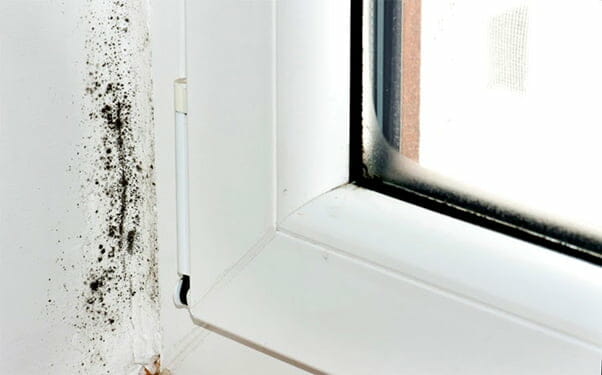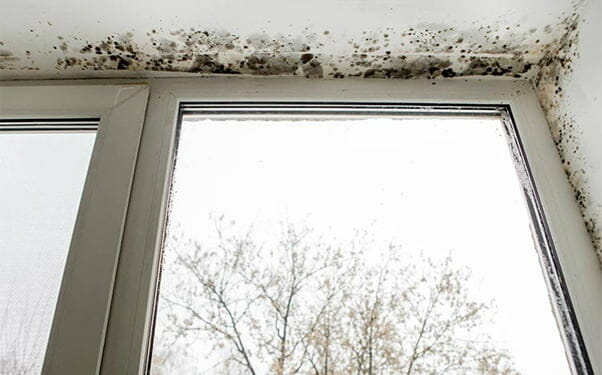Molds are microscopic living entities commonly found in damp areas of your house, such as near window frames, and they pose a risk to the health of your family members and could potentially lower your property’s value. This article will detail the steps to eliminate mold and provide valuable guidance on how to stop mold from spreading on your window ledges.
When mold is detected, remove it immediately using EPA-approved mold remediation techniques. Hire a mold remediation professional familiar with EPA guidelines on mold remediation in schools and commercial buildings to remove mold growth on surfaces exceeding 10 square feet. Practice EPA-approved moisture and mold prevention and control tips to prevent mold growth on your window.
Untreated mold can spread rapidly around your home and cause more damage resulting in massive mold remediation costs. Getting rid of mold is the best strategy for stopping mold growth on your window.
What we cover
ToggleWhat causes mold on windows & trim

The condensation of warm indoor air around colder window trim surfaces creates moisture, promoting favorable conditions for the growth of mold around windows. Drawn shades and window blinds can keep the air between the window and curtains at significantly lower temperatures than the rest of the house during cold weather periods. This situation provokes high precipitation levels around the window area, which causes dampness, resulting in the growth of mold.
Factors that allow the growth of mold around windows include:
- Broken window seals: broken, missing, or deteriorated window seals allow water to seep into the window cavity, causing mold growth. Plus, dirt containing mold spores can be blown through openings with missing seals, creating prime mold growth conditions.
- Degraded window frames: chemical or cement-based adhesives used to seal joints on window frames degrade over time, letting in water, which creates excellent mold growth conditions.
- Wrongly installed windows: allow rain and sleet into wall openings around the window areas prompting the growth of mold around windows and trims.
Use this FREE service.
HomeGardenGuides.com is a free service that quickly matches you with the top-voted mold remediation professionals.
You can get three quick estimates from certified professionals in your area in just 2 minutes by following the steps below.
- Scroll to the top of the page and enter your Zip code.
- Answer questions about your mold removal project.
- Your project details are forwarded to three local experts. They will send you a price estimate for the job and some friendly advice.
IMPORTANT: There is no obligation to hire. This is a free tool and service to be used at your pleasure.

What are the signs of window mold?
Black mold commonly found around window trims is a visible example of common household molds growing on windows, all of which share similar identifying characteristics.
Several signs may indicate the presence of window mold. They include:
- Musty smell: if you notice a strong and unpleasant moldy odor around your window area or on your curtain and window shades even after a thorough cleaning. You could likely have a window mold problem.
- Mold spots: you can identify mold growing on your window trim as a cluster of black or greenish spots or streaks on your window casings and surrounding walls. In extreme cases, greenish slime or furry green mold growing on window sills and adjoining walls is a sign of severe moisture accumulation within the window cavity.
- Peeling wallpaper: identifying traits of mold colonies growing on window trims takes on a different appearance when observed on the wallpaper around windows. Cracking, bubbling, and peeling wallpaper usually signifies the presence of moisture, and it is an early indicator that you could have a window mold problem.
- Recurring respiratory and cold symptoms: window mold could trigger unexplained asthma attacks in people with pre-existing respiratory problems. Also, it can cause minor to mildly severe cold symptoms, which include sneezing fits and a runny nose. When you are experiencing unexplained flu-like bouts that you can’t seem to shake off, then you could have a window mold issue. If you notice that these symptoms get triggered whenever beside a window or sitting on a nearby couch, that might be a clue.

Is window mold dangerous?
Contrary to popular opinion, diseases caused by window mold pose little danger to human beings with healthy immune systems. However, there are exceptions. Exposure to window mold can lead to opportunistic infections resulting in severe health problems in individuals with weakened immune systems or immune-suppressed patients on drug medication or undergoing prescription therapy.
Additionally, spores from mold growing on windows can get airborne within your home and infect humans when inhaled or if it comes in contact with the skin. Plus, people with pre-existing breathing problems can develop worsening symptoms if they have mold on their home windows.
You may experience the following symptoms following exposure to window mold spores. They are:
Allergic reactions
Window mold produces allergens, which can trigger delayed or instant allergic reactions in specific sensitive individuals. Allergic symptoms in humans include;
- Headache
- Runny nose,
- Red eyes,
- Sneezing
- Itching.
Irritation
microbial volatile organic compounds (VOCs) produced by window mold can set off irritation in individuals, including people who haven’t displayed any initial symptoms of mold allergies. When released into the air due to fungal metabolism,VOCs can cause eye and respiratory system irritation in exposed individuals. Symptoms include:
- Dizziness.
- Nasal irritation.
- Headaches.
- Nausea.
- Fatigue.
Increased asthma attacks
exposure to window mold can aggravate asthma attacks in individuals with pre-existing asthmatic conditions.
How to remove mold from windows and trim?
The process of removing mold from windows is easy and safe enough for homeowners to perform. All you require are a few household items like a spray bottle, paper towels, old (but clean) rags, plastic scraper, a brush, disposable plastic bags, a fan, or a hand dryer. You will also need vinegar and warm water for cleaning. However, ensure you observe safety protocols by putting on protective gear to prevent exposure to airborne mold spores.
You can safely remove mold from your windows and window trim by following the steps outlined below:
Identify and prepare the area.
- Spot and mark out the mold growth areas on the window, inner window frame, window seals, sill, etc.
- Seal doorways, air vents, and interior openings with plastic sheets to prevent airborne mold spores from escaping into other rooms in your home
- Open the specific window you are eliminating mold from to have better access. It also allows fresh air into the room and helps dry the window area.
Moisten the moldy window and trim with water.
- Squirt a mixture of dish detergent and warm water from a spray bottle all over the moldy window and casings. Ensure you saturate the entire window area to reduce mold spores’ release into the air while cleaning.
- Leave the mixture to soak for about 15 minutes.
Wipe away the excess mold.
- After 15 minutes have elapsed, put on a pair of protective gloves.
- Use paper towels or an old cloth dipped in the same mixture of dish detergent and warm water to gently wipe the excess mold off the window and trim surfaces.
- Concentrate only on removing the excess mold at this stage. Do not attempt to remove all the mold at once.
- Rinse the cloth you are wiping the mold off with inside warm water at regular intervals. If you are using paper towels, put all dirty paper towels in a plastic bag.
Scrape or scrub embedded mold.
- Spray detergent and water mixture on areas with hardened mold and leave to soak for 15 minutes.
- Use a plastic scraper to remove the ingrained mold from the window casings.
- You can use an old bottle brush or a discarded toothbrush to scrub mold growing in hard-to-reach areas, such as window tracks and window frame joints.
- Rinse your scraper or brush in clean water to remove the accumulated mold. Repeat the process until all the mold is gone.
Kill off the remaining mold spores.
- Dry the window and trim and assess your overall progress.
- If the mold is mostly gone, spray the window with white vinegar to kill the remaining mold spores. Please leave it to soak for several minutes.
- Put some baking soda on a piece of cloth, and use it as an abrasive to rub on the mold.
- Vinegar may not work effectively on windows with extensive mold. Instead, prepare a fungicide and water mixture and kill off the remaining mold on the window panes, frames, and sills.
Dry the window.
- Rinse the window with water and dry it with a piece of cloth.
- Leave the window open to allow the breeze to blow through and dry the casings. Place a fan or a hairdryer close by to hasten the drying process. Ensure the window and trim is fully dry to prevent the return of mold.
Dispose of all cleaning items properly.
- Collect all discarded paper towels, wipe cloths, and other debris.
- Please put them in a disposable plastic bag, seal the bag with tape and dispose of it in the trash.
Note: removing mold from wooden window casings is a complicated process involving the use of power sanding techniques and a HEPA vacuum. Hiring a professional mold remediation specialist is the safest option for removing mold from wooden window trims.

Tools & Safety equipment needed
Window mold removal, like every home improvement task, requires special tools to accomplish. Also, you will need to wear safety gear to avoid exposure to mold spores when working on moldy window surfaces. In this section, we will outline the equipment required to remove mold from your window and trim safely.
- Half mask or full-face respirators: prevents inhalation of mold spores released into the air during mold removal. A full-face respirator eliminates the need for goggles, and it offers better protection when removing mold from windows in areas with insufficient ventilation, such as basement windows. Half-mask respirators are available online and at hardware stores. Ensure your respirator complies with mandatory OSHA fitness requirements.
- Rubber gloves: wear protective rubber gloves to avoid hand contact with mold or chemicals that cause skin burns. Wear a pair of arm-length household rubber gloves when cleaning mold with mild detergents. However, we recommend wearing nitrile, polyurethane, or neoprene gloves that offer better protection when cleaning mold with industrial-grade fungicides or chemicals.
- Safety goggles: always have safety goggles when removing mold to protect your eyes from airborne mold spores that cause eye irritation.
- Protective clothing: reduce your skin exposure to mold spores by wearing disposable outer clothing covering your arms and legs. Also,full-body protective suits with attached hoods and booties used by professional mold remediators offer greater protection levels
- Fans: household electric fans quickly dry recently cleaned window areas whenever there is insufficient breeze or sunlight.
- Brush: an old bottle or bristle brush is required to reach mold embedded in window tracks or frame joints. Old toothbrushes are also handy tools to reach every nook and cranny if you don’t have a conventional brush.
- Plastic scrapers: these are effective mold removal tools whenever there is a need to remove ingrained mold on window frames and seals.
- Power sanders: are used to remove mold spores from porous surfaces like wood sills and frames where regular wiping isn’t sufficient to obliterate mold.
- HEPA vacuums: high-efficiency particulate air vacuums are used by mold professionals to quickly remove excess mold from windows and trims while minimizing the release of mold spores into the air.
- Disposal bags: these are essential items used to dispose of mold dust safely and discarded rags and paper towels are used to clean off mold from windows.
How to prevent mold from returning to windows
You can prevent mold regrowth on windows by following the steps below:
- Have a qualified professional install appropriate, high-quality insulated windows.
- Only use window frames with welded joints as they offer more resistance to moisture than frames that use sealants.
- Use specially formulated mold-resistant caulking to fill gaps around your windows and trim.
- Quickly wipe away the condensation on windows and trim to discourage the growth of mold.
- Open your shades as long as possible to encourage airflow within your home.
- Clear window weep holes of debris and dust to avoid blockage.
- Homeowners who live in a climate with high humidity can use a dehumidifier to maintain low moisture levels within the house.
- Keep your window shut before, during, and after storms.
- Operate your home thermostat at temperatures above 70 degrees.
- Use mold-resistant window seals.
FAQ's
How to get rid of moldy smells.
To get rid of moldy smells in your home, look for the source of the smell and remove it. Practice efficient ventilation, and use activated charcoal, baking soda, or other natural odor absorbers to get rid of moldy smells.
Will opening the window help with mold?
Opening windows help create sufficient airflow within a room, improving ventilation and ultimately preventing conditions that promote mold growth.
Does bleach kill mold?
Bleach can only kill surface mold on nonporous surfaces such as vinyl and metal. Bleach cannot kill mold spores and isn’t effective against mold growing on porous surfaces like wood or drywall.
What are the signs you are sick from mold?
Sickness as a result of mold infection Infections can manifest itself through the following symptoms:
- Watery eyes.
- Runny nose.
- Breathing problems.
- Headache
- Sneezing fits.
- Wheezing
- Nasal congestion.
- Fatigue
- Persistent coughs.














